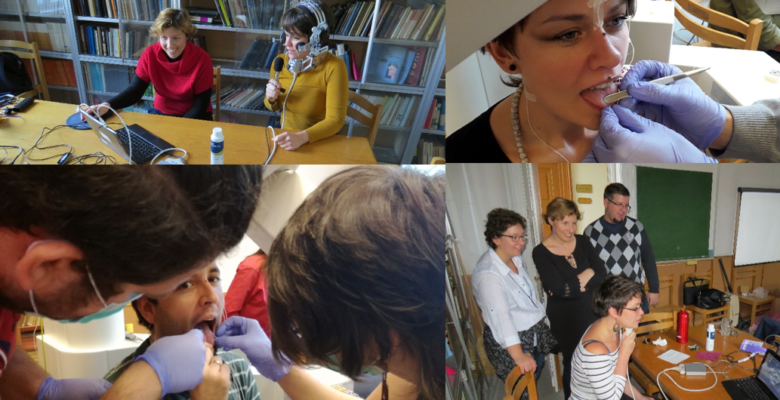Kutatás / Research
Research Topics
Also check out the site of the Department of Phonetics of Eötvös Loránd University, and the MTA-ELTE “Lendület” Lingual Articulation Research Group!
For publications connected to the projects below, go to Publications page.
Vowel variation
Voicing of the laryngeal fricative
The laryngeal fricative /h/ is claimed to be (breathy) voiced in some specific contexts generalizable over many languages. Yet, to date, little is known of the facilitating contexts of the voiced counterpart, not to mention the acoustic quality of this special voicing, and the articulatory and/or linguistic factors influencing it.
We investigate voicing characteristics of /h/ in Hungarian observing fine-grained phonetic variability, while we also try to take into account the articulatory mechanisms speakers use to produce vowels, voicing, and glottal frication.
Vowels in soprano singing
Sopranos are often required to sing at extremely high pitch. The articulatory maneuvers, however, singers use to increase fundamental frequency (f0) to these extremes are antagonistic to the production of certain vowel qualities. As a result, as singers raise the fundamental frequency of their voice, the vowels they produce become more and more distinct from their spoken counterpart — and merge into a unifrom /a/-like quality — both in production and perception. No wonder that we often experience serious problems understanding texts sung by these incredible performers…
We analyze articulation, acoustics, and percpetion of high-pitched sung vowels produced by professional (female) soprano singers in singing and speech, using all the nine qualitatively distinct vowels of Hungarian. In the articualtory studies we obtain EMA data, and compare vowels of German and Hungarian as well, which languages are different with respect to the density of their vowel spaces.
Vowels in motherese
According to Lindblom’s H & H theory, contrast is a crucial factor in speech production: in situations, in which the listener is assumed to be hindered in the speech perception task (due to e.g., adverse listening conditions or hearing loss), the speaker exaggerates contrast, hence (s)he makes the encoded information more accessible to the interlocutor. On this basis, linguistic contrast, e.g., the vowel length contrast is expected to be exaggerated in such speech styles as Lombard speech, i.e., speech produced in background noise, or in motherese, where the interlocutor is at an early stage of language acquisition.
In the Neurocognitive predictors of early language development [a korai nyelvfejlődés neuro-kognitív előjelzői] (NKFIH-K-115385) projekt we address the questions, if contrast exaggeration is observable in Hungarian primipara and multipara mothers’ infant-directed speech, if the contrast enhancement shows language-specific traits, and if contrast exaggeration is in any way correlated with the infant’s age and stage of language acquisition.
Sociophonetics — identification of innovative language users
Investigation of language change is a key issue in sociolinguistics, but is also very challenging to tackle, as the process of change very often stretches over several lifespans. Nevertheless, sociolinguists since Labov try to identify and investigate ongoing change, mainly by identifying innovative and conservative speaker groups, and the analysis of their linguistic behavior. This way of research, however, can easily turn into being circular, if the variables of interest are also used as variables designating the innovative and conservative speaker groups in which the use of these specific linguistic variants is analyzed afterwards.
We contributed to this field of research by adapting a test from social psychology, the implicit association test (IAT), that is capable of detecting “more lenient”, and “less lenient” listeners with respect to the innovative and conservative linguistic forms they tolerate. The detection via LI-IAT is done independently of the linguistic variable(s) we set to examine from the perspective of change, and thus allows for the investigation of linguistic change more reliably.
